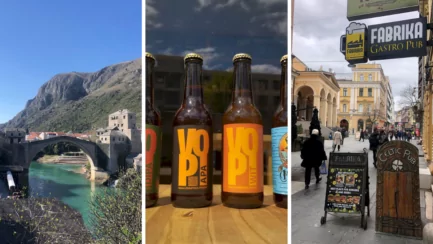Yesterday we spent ten minutes in Bosnia, or Bosnia and Herzegovina as the country is actually called. Yes, you heard right, ten minutes! If you've driven from Dubrovnik in southern Croatia to the north of the country, you'll understand exactly why - it's impossible to move on in Croatia without passing through Bosnia. I hadn't actually thought about it before, but the southern part of Croatia is not connected to the rest of the country.
Short visit
We drove the short distance through Bosnia and Herzegovina without doing anything special. We can only note that the country got a very small beach strip (24 km around the city of Neum). The road and landscape look like in Croatia, and there is not much to indicate that you are suddenly in another country.
After our ten minutes in the country, we continued into Croatia again, on the northern side of the Bosnian border, and then travelled by ferry to the island of Hvar.


Briefly about Bosnia and Herzegovina
The country has just under 4 million inhabitants and is populated by Bosniaks, Serbs and Croats. The very first Bosnian state was formed in the 12th century and lasted until 1463, when the country was conquered by the Ottoman Empire. In 1878, the country was occupied by Austria-Hungary and after World War I it became part of Yugoslavia.
With Bosnia's independence, a 'Serbian Republic' was declared and, with the help of the Yugoslav army and troops from Serbia and Montenegro, around 70 per cent of Bosnia's territory was occupied. This was the beginning of the Bosnian War, in which 110 000 people lost their lives. The war ended in 1995 after pressure from NATO and other international bodies.
The peace agreement gave Serbs a majority in one of the country's "entities" (Republika Srpska), while Bosniaks and Croats have a majority in the other "entity" (the Federation of Bosnia and Herzegovina). After the war, NATO had peacekeeping troops in the country for a long time. In 2004, the EU took over the task and today there are about 2000 EUFOR troops stationed in Bosnia and Herzegovina, which is now a candidate for both the EU and NATO.

Did you miss the previous post on the 2015 motorhome trip? Read the Luxury camping in Dubrovnik - experience Solitudo

















Ama de casa says:
Wow! That's a lot of time you gave Bosnia. You must have had plenty of time! 😉
I also have not thought about the fact that it looks like that on the map (although I must admit that I am extremely bad in general about what it really looks like there in the former Yugoslavia at all...). Fun for Bosnia to get a small coastal strip in any case 🙂 ðŸ™'
17 September 2015 - 9:55
Mr Steve says:
Thanks for that history and geography lesson I had no idea that Croatia is divided.
17 September 2015 - 14:48
Lennart says:
We rolled that way down!
Live well!
17 September 2015 - 15:18
BP says:
Yes, what you learn when you read your blog. I also had no idea that Croatia is "divided" by Bosnia.
It must have been the shortest visit anyone has ever spent in a country;-)
17 September 2015 - 17:03
Veiken says:
I was in Bosnia and Herzegovina in the early 2000s on a study trip and it was incredibly interesting! You could see traces of the war everywhere!
17 September 2015 - 19:28
Veiken says:
Herzegovina is the name! Carelessness!!!
17 September 2015 - 19:29
admin says:
Ama de casa, yes we looked around properly... 😉 The map is something I am gradually getting better at when travelling 😉.
Steve, you learn when you travel! (And when you read blogs ;))
Lennart, yes, I can understand that!
BP, haha, yes it probably qualifies as our shortest visit to a country ever! 😉
Veiken, I understand that it was interesting! You can certainly still see traces of the war, albeit to a lesser extent.
17 September 2015 - 20:08
Maggan and Ingemar says:
We did not stop but went straight through. It will be interesting to read about the islands. We thought of visiting them, but the weather was too bad. See that you will also get some rain on you, but you seem to have warm weather. Glad you visited Dubrovnik. When are you planning to be in Sweden? We are heading south sometime around the 10th of October. It's starting to pull the "travel gut" now 😀.
Goodbye.
17 September 2015 - 21:11
admin says:
Maggan and Ingemar, we are very warm now, around 30 during the day and over 20 at night. But we have also seen that there will be rain later. We have to be in Stockholm by 1 Dec. Since it will be cold, we want to stay in Croatia as long as possible. Are you travelling to Portugal and Spain this time?
18 September 2015 - 7:21
s p i n d e l t j e j e n says:
Will you go into Bosnia more? We have been in Mostar - great old town! 🙂
18 September 2015 - 10:31
Motorhome Helge says:
We took the local bus from camping Podaca to Dubrovnik and then it was important to have the passport with us in the backpack, so as not to be thrown out at the border control. They told us at the camp reception, which we thought was thoughtful.
20 September 2015 - 8:36